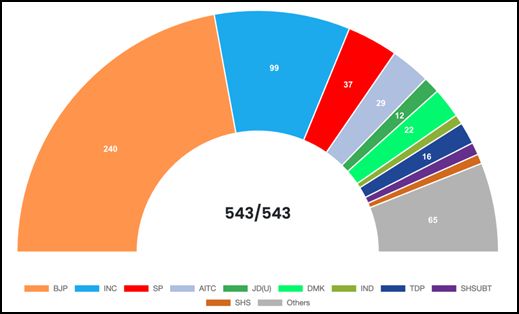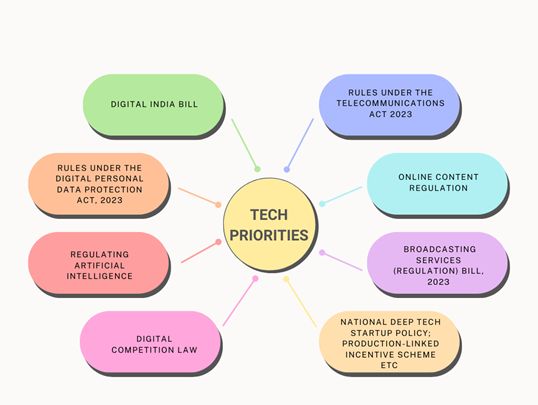As the dust settles, and Prime Minister Modi and his NDA 3.0 cabinet embark on their third term, we take a look at how the election unfolded and what implications it holds for tech policy in India.
The Great Indian Elections have ended, and the results are in! Despite the Bharatiya Janata Party (BJP) led National Democratic Alliance (NDA) surpassing the majority threshold of 272 seats with a total of 292 seats, the BJP saw an unexpected dip in its electoral performance, securing 240 seats. Meanwhile, the Indian National Congress (INC) led Indian National Developmental Inclusive Alliance (I.N.D.I.A) made notable strides, winning 235 seats overall, with the INC increasing its seat share from 52 to 99.
As the dust settles, and Prime Minister Modi and his NDA 3.0 cabinet embark on their third term, we take a look at how the election unfolded and what implications it holds for tech policy in India.
What happened with the elections?

Source: Imgflip
The 2024 Lok Sabha Election ended up being much closer than many mainstream predictions. While the BJP did not reach the halfway mark of 272 seats on its own, it remains the single largest political party by a significant margin, with 240 seats. With the crucial support of NDA partners including the Telugu Desam Party (TDP), Janata Dal (United) (JDU), Shiv Sena (SS), Janata Dal (Secular) (JDS), Hindustani Awam Morcha (Secular) (HAM-S), Apna Dal (Secular) (AP-S) and Lok Janshakti Party (Ram Vilas) (LJP-RV), Prime Minister Modi made history as he became only the second Prime Minister of India, after Jawaharlal Nehru, to win three consecutive terms in government.
The BJP's vote share only fell marginally from 37.3% in 2019 to 36.6% in 2024. However, its seat tally dropped by a massive margin of 63, with it coming down from 303 in 2019 to 240 in 2024. In 2014, too, the BJP won 282 seats, while the NDA won a total of 336 seats. INC, on the other hand, saw its vote share increase from 19.5% in 2019 to 21.2% in 2024 but saw a big jump in its seat share from 52 in 2019 to 99 this time around. Uttar Pradesh and Maharashtra were big misses for the NDA, with the I.N.D.I.A making headway there. However, the NDA did win big in Andhra Pradesh and Odisha, and also saw its first MP elected from Kerala.
In 2014 and 2019, the BJP benefited from a divided opposition. Instead of confronting a united front, the BJP encountered multiple opposition parties that were as focused on competing against each other as much as they were inclined to challenge the BJP. This led to a split in the opposition that ultimately worked to the advantage of the BJP. Following two consecutive parliamentary election losses, the opposition resolved to learn from its past mistakes. In July 2023, over two dozen opposition parties declared the formation of a new coalition, the I.N.D.I.A. Needless to say, the alliance worked and put up an unexpectedly good performance.

Source: Election Commission of India
|
Alliance |
Seats (2024) |
Seats (2019) |
|---|---|---|
|
National Democratic Alliance (NDA) (Incumbent) |
290 |
353 |
|
Indian National Developmental Inclusive Alliance (I.N.D.I.A.) (Opposition) |
235 |
Alliance did not exist |
|
Party |
Seats |
Seats |
|
Bharatiya Janata Party (BJP) |
240 |
303 |
|
Indian National Congress (INC) |
99 |
52 |
|
Samajwadi Party (SP) |
37 |
5 |
|
All India Trinamool Congress (AITC) |
29 |
22 |
|
Dravida Munnetra Kazhagam (DMK) |
22 |
24 |
|
Telugu Desam Party (TDP) |
16 |
3 |
|
Janata Dal - United (JDU) |
12 |
16 |
|
Shiv Sena (Uddhav Balasaheb Thackeray) (SSUBT) |
9 |
18* |
|
Nationalist Congress Party (Sharad Pawar) (NCPSP) |
8 |
5* |
|
Others |
71 |
87 |
|
*Shiv Sena (SS) and Nationalist Congress Party (NCP) underwent a split in 2022 and 2023 |
||
New government in. What is going to change?
For the first time since coming to power in 2014, the BJP has to reckon with not having a majority by itself in the Parliament. Navigating the complexities of coalition politics is back in India's lexicon. While coalition governments bring in more representation and checks on power, they are also less stable than single-party governments. With other parties in power, we will see greater deliberations on policies within the government, which can diversify the government's agenda. However, it is also likely that disagreements among coalition partners can lead to political instability, frequent reshuffling of ministers, and even the collapse of the government. Over the next five years, the BJP will have to ensure that its coalition partners are aligned with its governance vision and skillfully negotiate differences in order to remain in power. Particularly, TDP with 16 seats and JDU with 12 seats are crucial for the NDA to stay afloat above the 272 mark.
Another significant development we may witness is a shift away from the policy-making centralization that has characterized the last decade, where the Prime Minister's Office has driven decisions across all domains. A coalition government is likely to lead to a more decentralized approach to policy-making. This unique coalition still has one party with a massive majority forming the core, and smaller regional allies on the periphery. With allies, there will now be a fair amount of accountability, checks, and balances. But these are still very early days.
Overall, with several ministers in the cabinet retaining the previous ministries they held - such as Ashwini Vaishnaw for the IT Ministry and Railways, Nirmala Sitharaman for the Finance Ministry, Dr. S. Jaishankar for External Affairs and Nitin Gadkari for Ministry of Road Transport and Highways - there is a signaling of policy continuity in the government.
On the IT Ministry front: Ashwini Vaishnaw, the previous IT Minister, was sworn into the Rajya Sabha (Upper House) before the elections began, indicating that he was critical enough for the BJP to ensure his continuation without being subjected to the rigours of the electoral contest. Vaishnaw retained the IT Ministry and Railways portfolio along with taking charge of the Information & Broadcasting Ministry (MIB). Having already delivered on key technology legislations, the Digital India Bill and Broadcasting Services Regulation Bill are also likely to see swift movement once Vaishnaw takes office. With him managing both the IT Ministry and MIB- several issues of overlap, such as regulation of OTT players, content moderation, and matters pending in litigation such as the provisions relating to implementation of Part III of the Information Technology (Intermediary Guidelines and Digital Media Ethics) Rules, 2021 (IT Rules) may possibly see streamlining.
As Rajeev Chandrasekhar was unable to win his seat in Thiruvananthapuram in the Lok Sabha election, he has also been unable to retain a spot in the newly formed cabinet. Jitin Prasada has been appointed as Minister of State (MoS) for the IT Ministry. Previously a member of the INC, he was first elected to the Lok Sabha in 2004 and served as the Minister of State for Steel in 2008. In 2021 he left the INC to join the BJP and now takes charge as MoS for IT. After Rajeev Chandrasekhar's term as MoS, it will be interesting to see how Prasada takes charge. Particularly, it will be interesting to see if he is going to be as active as Rajeev Chandrasekhar on X (formerly Twitter) - to tackle India's IT issues one tweet at a time.
What the cabinet looks like?
With 71 ministers swearing-in along with Prime Minister Narendra Modi, the NDA cabinet looks like this:
|
Prime Minister |
|---|
|
Narendra Modi Also in-charge of: Ministry of Personnel, Public Grievances and Pensions; Department of Atomic Energy; Department of Space; and all other portfolios not allocated to any Minister |
|
Cabinet Ministers |
|
BJP: Rajnath Singh, Amit Shah, Nitin Gadkari, JP Nadda, Shivraj Singh Chouhan, Nirmala Sitharaman, S Jaishankar, Manohar Lal Khattar, Piyush Goyal, Dharmendra Pradhan, Giriraj Singh, Ashwini Vaishnaw, Jyotiraditya Scindia, Bhupender Yadav, Gajendra Singh Shekhawat, Hardeep Singh Puri, Mansukh Mandaviya, G Kishan Reddy, Sarbananda Sonowal, Dr Virendra Kumar, Pralhad Joshi, Jual Oram, Annapurna Devi, Kiren Rijiju, CR Patil. Allies: HD Kumaraswamy (JD(S)), Jitan Ram Manjhi (HAM), Rajiv Ranjan Singh alias Lalan Singh (JDU), , Kinjarapu Ram Mohan Naidu (TDP), Chirag Paswan (LJP). |
|
Ministers of State With Independent Charge |
|
BJP: Rao Inderjit Singh, Jitendra Singh, Arjun Ram Meghwal, Allies: Prataprao Ganpatrao Jadhav (Shiv Sena), Jayant Chaudhary (RLD). |
|
Ministers of State |
|
BJP: Jitin Prasada, Shripad Naik, Pankaj Chaudhary, Krishan Pal Gurjar,, Nityanand Rai,, V Somanna,, SP Singh Baghel, Shobha Karandlaje, Kirti Vardhan Singh, BL Verma, Shantanu Thakur, Suresh Gopi, Dr. L Murugan, Ajay Tamta, Bandi Sanjay Kumar, Kamlesh Paswan, Bhagirath Chaudhary, Satish Chandra Dubey, Sanjay Seth, Ravneet Singh Bittu, Durga Das Uikey, Raksha Khadse, Sukanta Majumdar, Savitri Thakur, Tokhan Sahu, Rajbhushan Chaudhary, Bhupathiraju Srinivasa Varma, Harsh Malhotra, Nimuben Jayantibhai Bambhaniya, Murlidhar Mohol, George Kurian, Pabitra Margherita. Allies: Ramdas Athawale (RPI), Ram Nath Thakur (JDU), Anupriya Patel (Apna Dal), Dr Chandra Sekhar Pemmasani (TDP). |
| Some Important Portfolio Allocations | |
|---|---|
|
Ashwini Vaishnaw |
Minister of Railways Minister of Information and Broadcasting Minister of Electronics and Information Technology. |
|
Amit Shah |
Minister of Home Affairs Minister of Cooperation |
|
Nirmala Sitharaman |
Minister of Finance Minister of Corporate Affairs |
|
Dr. Subrahmanyam Jaishankar |
Minister of External Affairs |
|
Piyush Goyal |
Minister of Commerce and Industry |
|
Jyotiraditya M. Scindia |
Minister of Communications Minister of Development of North Eastern Region |
|
Raj Nath Singh |
Minister of Defence |
|
Pralhad Joshi |
Minister of Consumer Affairs, Food and Public Distribution Minister of New and Renewable Energy |
What's happening next?
With the Cabinet appointed, the government will start carrying out its business in the Parliament. The first session of the 18th Lok Sabha has been scheduled between 24th June to 3rd July 2024. This will see the NDA take up matters that have been left pending since its last term. The scheduled session is much shorter than the first session of the 17th Lok Sabha, which was held between 17th June to 7th August 2019. So it's likely that we may see another session being called in mid-July or August. The first order of business - the budget. We had the interim budget presented in February 2024 and now it's time for the real deal. Once again, the BJP will have to contend with buying in the approval of its coalition partners. Given the coalition, the budget, any economic reforms and policies, will be subject to greater scrutiny from the BJP's coalition partners, possibly leading to more cautious economic strategies.
What technology-related items are likely to be picked up?

Omnibus overhauls: A key agenda for the new government is to overhaul India's technology regulation framework with the proposed Digital India Bill. This future-ready legislation aims to comprehensively regulate the digital economy, replacing the Information Technology Act of 2000. The legislation will address intermediary liability, AI, digital competition, cybersecurity, e-commerce, gaming, and more, working alongside other regulations like the Digital Personal Data Protection Act, 2023, and the National Data Governance Framework. The IT Ministry, previously led by Rajeev Chandrasekhar, has already conducted two public consultations on the Act's framework, indicating progress on a draft law. However, with Chandrasekhar's departure, the Act's direction may change under new leadership. This presents an opportunity for further consultation on crucial issues like AI regulation, safe harbor protections, and platform regulation to shape India's digital future effectively.
Data Protection: Top on the IT Ministry's agenda is finalizing the Rules under the Digital Personal Data Protection Act (DPDPA), enacted in August 2023, following several iterations of a proposed data protection framework. Designed to be agile and flexible, the Act aims to be future-proof, regulating emerging challenges effectively. However, without the Rules, businesses remain uncertain about compliance requirements. The government must prioritize issuing these Rules to implement the Act fully.
Industry bodies have already highlighted the difficulty in understanding compliance obligations and adapting business models to the DPDPA, in the absence of the Rules. Whenever the Rules come out,they must undergo robust public consultation due to their widespread impact, and eventually a reasonable transition period should be given as business' revamp their architecture to ensure compliance.
Artificial Intelligence: AI has been a critical legal and policy focus in India for the past few years, and its governance will remain a key priority for the new government. The spate of advisories issued between November 2023 and March 2024 that were targeted towards deepfakes on the internet, gave some insight into the government's thinking on AI regulation with a quasi-licensing regime being quickly pulled back after industry wide pushback. Since then, a high-powered committee, led by the Principal Scientific Advisor (PSA) to the Government of India, has also been working on developing a framework for AI governance. India's geopolitical ambitions to be the voice of the Global South on AI governance and ensuring equitable governance frameworks will also be important factors that shape regulation domestically. With the upcoming mid-year Global Partnership on AI summit in July, India will look to bolster the IndiaAI mission that saw a large INR 10,000 crore outlay pre elections. Another crucial aspect of AI development is fostering indigenous chip manufacturing to support India's AI aspirations. Minister Ashwini Vaishnaw has been a strong advocate for making India a chip manufacturing hub, especially in the context of the global AI race. Thus, India's semiconductor manufacturing ambitions will remain integral to the NDA 3.0 government.
Digital Competition: Over the past two years, the Committee on Digital Competition Law (CDCL) examined the need for a separate digital competition law in India. The CDCL, in March 2024, released its report with a draft Digital Competition Bill. The draft law proposes ex-ante regulations. It seeks to address specific anti-competitive practices, including prohibiting anti-competitive self-preferencing, deep discounting and cross-utilization of data.
Telecom: We are also likely to see Rules published under the Telecommunications Act, 2023 passed in December 2023. The Department of Telecommunications is drafting these rules, with a substantial portion reportedly completed. As the earlier draft of this law - the 2022 Telecommunications Bill, was published against the backdrop of Telecom Service providers seeking parity in regulations with OTT communication services, the issue of including OTT communications within the scope of the Bill remains and may be a key point of consideration for the new Minister. So, as we await Rules under the Telecommunications Act, one thing to look out for is how it will interact with the services provided by OTT players.
Content regulation: Over the past year, regulating misinformation and deepfakes has been a major concern for the government, with regulatory response triggered by viral anecdotal incidents and the need to preserve the integrity of the electoral process. The IT Ministry issued multiple advisories targeting deepfake content created by generative AI and called on greater responsibility from platforms and users. With synthetic content technology rapidly developing, these issues will continue to be on the regulatory boil with the next trigger incident likely to see more prescriptive regulatory intervention.
With Ashwini Vaishnaw now overseeing the MIB, heightened activity around the Broadcasting Bill is expected. There has been little movement on the Bill since public comments were received last January 2024. The proposed regulation of news and current affairs content creators on social media platforms, along with increased control over OTT curated content, are likely to be key flashpoints as the Bill progresses.
Digital ads also are currently under intense regulatory scrutiny due to the Supreme Court's mandate for self-declaration, causing widespread concern across the ads ecosystem. The MIB's guidelines requiring compliance by June 18th 2024 have faced significant resistance, highlighting practical challenges and the sheer volume of ads. Despite this, the MIB is unlikely to amend its stance in response to the Supreme Court's order, potentially requiring stakeholders to seek relief directly from the Court. There have been developments on ad-revenue sharing, with the MIB holding initial discussions with the Digital News Publishers Association to address their concerns on the matter.
The other big things: While the online gaming industry deals with the GST fallout and awaits the Supreme Court's substantive hearing, it looks to the central government for much-needed regulatory clarity. The government's next approach is crucial, especially since self-regulation, despite being introduced into law via the 2023 amendments to the IT Rules, has not received political approval.
The National Deep Tech Startup Policy may also be picked up, alongside a potential review of the Production-Linked Incentive Scheme. The priority under this is likely going to be on improving indigenous manufacturing and capacity-building focused on skill development and employment. India's chip manufacturing experiment, which we are yet to see take off, is also likely to be in the spotlight again with an emphasis on indigenous manufacturing.
Given the Securities Exchange Board of India's willingness to explore regulation of crypto-trading, we may potentially see at least movement on this. If not regulations and guidelines on the matter, whitepapers for public consultation may be put out by the regulator.
Cybersecurity could also be up on the agenda given the need for India to improve its cybersecurity preparedness and awareness. On this front, it is likely that we'll see more awareness building-related priorities by the IT Ministry. The Digital India Bill could also create further and specific penal provisions related to cybercrimes to complement the existing framework under the Indian Penal Code, and the Information Technology Act (which it will replace).
The content of this article is intended to provide a general guide to the subject matter. Specialist advice should be sought about your specific circumstances.


